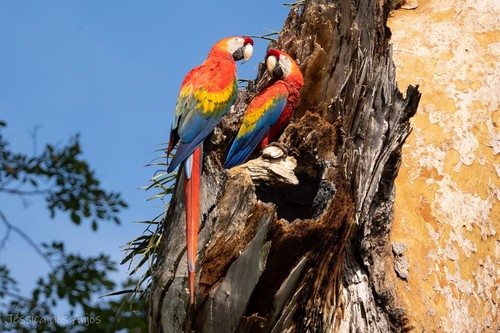
Scarlet Macaw
The Scarlet Macaw (*Ara macao*) is a large, strikingly colored parrot native to humid evergreen forests of tropical America. Renowned for its vibrant plumage—a brilliant combination of red, yellow, and blue—it's an iconic symbol of the Neotropics. Ecologically, Scarlet Macaws play a crucial role as seed dispersers, influencing forest regeneration. They are highly intelligent and social birds, often seen flying in pairs or small groups, and their loud calls echo through the canopy. Culturally, they have been revered by indigenous peoples for centuries, often appearing in art and mythology.
81-96 cm
Length
100-120 cm
Wingspan
Least Concern
Conservation Status
Distribution
The Scarlet Macaw's range extends from southeastern Mexico through Central America (Belize, Guatemala, Honduras, Nicaragua, Costa Rica, and Panama) and into South America, encompassing the Amazon Basin (Colombia, Venezuela, Guyana, Suriname, French Guiana, Ecuador, Peru, Bolivia, and Brazil). They have also been introduced to some areas, such as Puerto Rico.
Lifespan
40-50 years in the wild; up to 75 years in captivity.
Scarlet Macaw's Habitat
Habitat Types
Humid lowland rainforests, River-edge forests, Savannas with gallery forests, Open woodlands
Climate Zones
Tropical
Adaptations
Scarlet Macaws have powerful beaks adapted for cracking hard nuts and seeds. Their zygodactyl feet (two toes pointing forward and two backward) provide excellent grip for climbing and manipulating objects. They are also strong fliers, capable of covering long distances in search of food.
Variations
Two subspecies are generally recognized: *Ara macao macao* (found in South America) and *Ara macao cyanoptera* (found in Central America, slightly larger and with more blue on the wings).
Appearance
Breeding Plumage
No significant difference.
Seasonal Feather Changes
None
Sex Based Plumage Differences
Minimal; males and females have similar plumage.
Notable Features
Predominantly scarlet red body plumage., Bright yellow wing coverts., Blue flight feathers and rump., Large, powerful, pale-colored beak., Bare white facial skin patches with fine red feather lines.
Diet and Feeding
Primary Foods
Seeds, Nuts, Fruits, Flowers, Nectar, Insects (occasionally)
Foraging Behavior
Scarlet Macaws forage primarily in the canopy, using their strong beaks to crack open hard-shelled nuts and seeds. They often gather at clay licks, consuming soil believed to neutralize toxins in their diet.
Specializations
Their powerful beak is a key specialization, allowing them to access food sources unavailable to many other birds. Their consumption of clay is a unique adaptation.
Seasonal Diet Variations
Their diet varies depending on the availability of fruits and seeds throughout the year. During the breeding season, they may consume more insects to provide protein for their chicks.
Behavior
Social Structure
Scarlet Macaws are highly social birds, usually found in pairs, family groups, or small flocks. Larger flocks may form at feeding sites or roosts.
Communication
Loud, raucous calls, Squawks, Screams, Visual displays (head bobbing, wing flapping)
Migration
Generally non-migratory, but may make local movements in response to food availability.
Territorial or Group Behaviors
Pairs defend their nesting territory during the breeding season. Outside of breeding, they are generally tolerant of other macaws.
Conservation
Threats
Habitat loss (deforestation for agriculture and logging), Illegal pet trade (capture of chicks and adults), Hunting (for food and feathers in some regions), Persecution (as crop pests)
Protection Programs
CITES Appendix I (prohibits international trade), Protected areas (national parks and reserves), Community-based conservation initiatives, Reforestation projects
Local National Laws
Protected by national laws in most countries within their range.
Population Trend
Decreasing
Population Estimates
Estimated at 20,000-50,000 individuals, but numbers are declining in many areas.
Interesting Facts
Scarlet Macaws can mimic human speech.
Like many parrots, they have a remarkable ability to learn and repeat words and phrases.
They are one of the largest parrot species in the world.
Their impressive size and vibrant colors make them a truly spectacular sight.
Scarlet Macaws mate for life.
These strong pair bonds contribute to their social stability and cooperative breeding.
They use their feet like hands.
Their zygodactyl feet allow them to hold and manipulate food with great dexterity.
They can fly at speeds of up to 35 miles per hour.
To look for food and avoid predators.
Faqs about Scarlet Macaw
What is the biggest threat to Scarlet Macaws?
Habitat loss due to deforestation and the illegal pet trade are the primary threats.
Are Scarlet Macaws good pets?
Scarlet Macaws are highly intelligent and social birds, but they are not suitable pets for most people. They require specialized care, large enclosures, and a significant time commitment. Their loud vocalizations and destructive chewing habits can also be challenging. Furthermore, their capture for the pet trade has significantly harmed wild populations. Consult a professional for expert advice.
How can I help Scarlet Macaws?
Support organizations working to protect their habitat, advocate for stronger laws against the illegal wildlife trade, and avoid purchasing products made from tropical hardwoods that contribute to deforestation.
Do Scarlet Macaws use tools?
While they don't use tools in the same way as some primates, they do use their beaks and feet in a highly manipulative way, which could be considered a form of tool use.
Can Scarlet Macaw eat clay?
Yes, they can. It is believed that the clay helps neutralize the toxins from the seeds they eat.
Copyright @ Nature Style Limited. All Rights Reserved.
 English
English